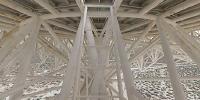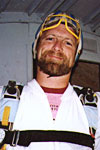© 2006 Pat Swovelin, All Rights Reserved.
It was a windy day (it increased to 39 MPH later in the afternoon when I was climbing the superstructure to the collector array platform, yowzers!) and standing there under the dish it looked and felt very "soft." There was a lot of reflected light coming from the desert floor so there were no hard shadows anywhere and the special NASA-approved pastel-white paint is completely oxidized from being in the sun every day making it appear even "softer" than when it was last repainted. The dish is 40 years old and still in daily use although my (soon-to-be-15-year-old-the-next-day) son and I were there on a day when it wasn't in use (or we couldn't have filmed in it). Because it's a radio telescope it's not light-based and isn't limited to nights only, so it can work 24 hours a day. Like all modern telescopes it can be controlled with Net-access to enable scientists from all over the world to use it (assuming they have permission and the codes to get in).
To get to where this panorama was shot you enter the base of the pedestal (on the opposite side) and climb a set of circular stairs that wraps once around the inside of the pedestal. Then you exit on the side of the pedestal through another watertight hatch onto a small platform, climb another narrow set of stairs that wraps another 1/4 of the way around the outside of the pedestal putting you on a catwalk that goes most of the way around the pedestal. This catwalk allows access to the exterior gears, motors and whatnot that tilts the dish. Walking another 1/4 of the way around the pedestal you reenter it through another watertight hatch, climb across an open shaft that houses the dish's rotational shaft and mechanism and climb another ladder in the middle of this shaft housing (yet another good place not to fall). Now you are in a large horizontal tube housing the tilt shaft of the dish. Climbing another short ladder allows you to open the final watertight hatch and exit up to another ladder above the opening (visible when you tilt the panorama down). This puts you on the final catwalk that wraps around to the left (where the panorama was shot), from there you go up the ladder/stairs through the trap door into the dish itself.
When you emerge in the dish you are about 10' off to the side of the center and you are surrounded and enveloped by the massiveness of the dish and the superstructure above you (130' doesn't seem big until you're in the middle of it). Everything is glowing in the soft white of NASA-approved completely oxidized paint while the brilliant deep blue sky is gleaming down at you in super-high contrast to the soft white around you. All of this is happening while the wind is howling all around the dish but it's dead calm and eerily quiet inside where you are (cue the Twilight Zone theme).
Our guide left and we ... were alone. (major ominous chord, DUN DAAH!) When we closed the trap door hatch to shoot we decided that doing something silly like allowing it to close and hear the dreaded "click" come from the other side of the hatch would be way less than brilliant so we made sure to wedge the lock pin in the opening just to be sure we'd be able escape (when the space ships started to land later in the episode, see "Twilight Zone" above).
Climbing up through the pedestal and into the dish with all of my panorama gear was nothing compared to what I went through when I did the same thing with a very heavy Panavision Gold 35mm motion picture camera in late '95 to shoot scenes of The Arrival starring Charlie Sheen. That was tough, this time it was easy. Back then I was 1 of 5 select people on the crew to get to go in the dish that day and now I hold the distinction of being the only person to shoot in the dish twice. I'm quite probably the only person to shoot in there other than scientists and maintenance types.
With that and 50¢ I can buy coffee. Swell...
Later in the day, after we got back from the CARMA site, I put on a safety harness I'd found earlier in the pedestal and climbed the superstructure leading to the collector array platform while the wind was blowing at my chest at 39 MPH (I wouldn't have minded it as much if the wind was blowing at my back pinning me to the ladder, but noooooooooo, it was blowing the other way and trying to kill me). It wasn't what you'd call ideal panorama shooting conditions; holding on for dear life with one hand, holding the camera on a monopod in another hand, pulling myself up the ladder with my 3rd hand, moving the safety line up a few rungs with my 4th hand, then at the top trying to frame the shot as the camera is being blown all over the place and wondering what hand I'm going to use to fire the camera with (my 5th hand?). Meanwhile the wind is desperately trying to blow me off to either:
- End up dangling head down from the safety line 50' above my son's head with the car keys in my pocket and everyone else already gone home because it's late plus it's Friday so they won't find my body for 2.5 days (did I mention it was really cold?). (not a good proposition)
- Have the safety line release and hear my son say "Hi, Dad!" as I hurtled past his feet and crashed right through the thin skin of the dish only to bounce Homer Simpson-like off of a dozen or so of the dish's huge framing tubes (saying "D'oh!" with each hit) and fall another 75' to the desert floor to bounce a couple of more times (accompanied by the obligatory "D'oh!"s). (this would be what is normally called "bad" and makes the dangling bit seem good by comparison)
- I lived to tell the tale.
- I saw the panorama of me on the superstructure with a silly grin on my face and the entire 40M dish (with my son in it twice) and the desert laid out below me.
- The boss didn't beat me over the head with a rolling pin after we got home and told her the story of our big day (whew!).
Amazingly one of them later said "A telescope control room?"
Walt Disney was right, it is a small world after all.
If you'd like to see more of what scientists are doing in California's High Desert I have other panoramas and stills (on my site) of the 40M dish and the new CARMA (Combined Array for Research in Millimeter-wave Astronomy) facility that's under construction 20 minutes away up in the nearby White Mountains.
All in all this was yet another big Dadventure my son and I experienced together.
Lat: 37° 13' 53.58" N
Long: 119° 17' 58.31" W
Elevation: 3957'
Precision is: High. Pinpoints the exact spot.



 Tap or click the zoom icon in the bottom right corner of the picture to switch between in-page and fullscreen view
Tap or click the zoom icon in the bottom right corner of the picture to switch between in-page and fullscreen view